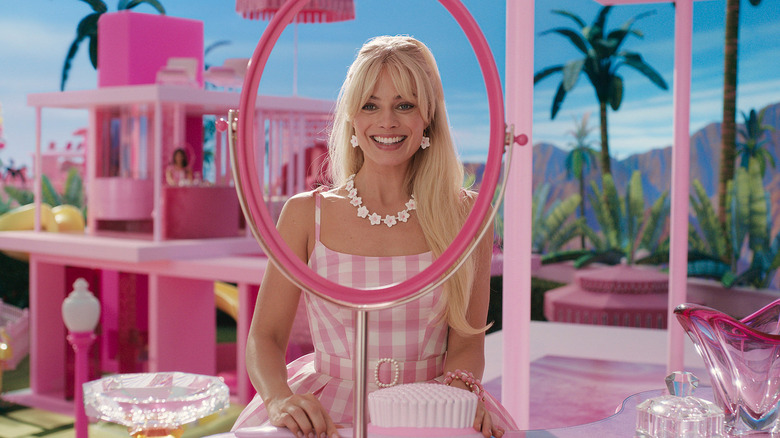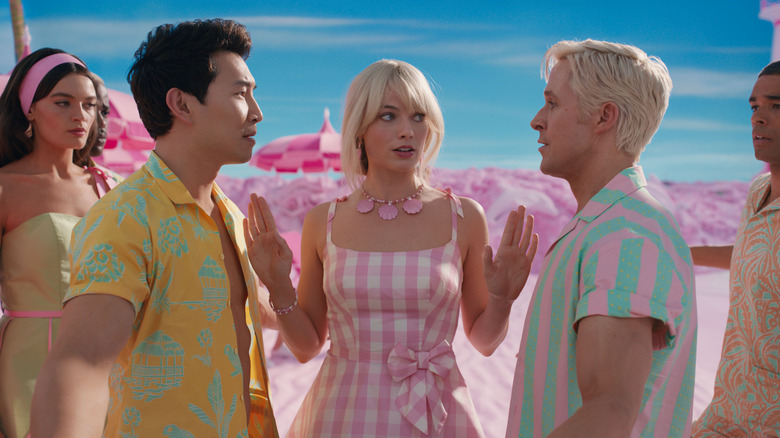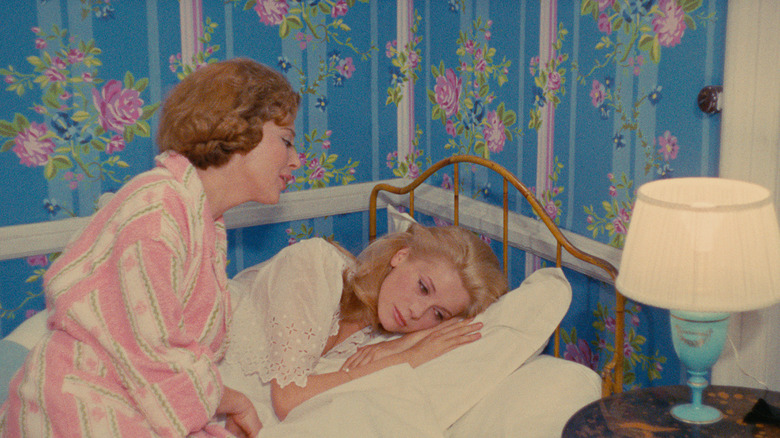All The Pink On Barbie's Set Created A Magenta Nightmare For The Lighting Crew
When the human eye stares at one color for too long, it experiences a phenomenon known as cone fatigue. The cones in one's eyes are the cellular photoreceptors that process color and are particularly good at processing reds, blues, and greens. And, yes, cones can get tired of looking at certain things. For instance, when one stares at the color red for too long, the cones wear themselves out and fall into a state of complete rest. As a result, the eye will produce a "ghost" spectrally opposite image of red when it looks at a white area. Test it out! Stare at a red spot for about 30 seconds without blinking, then glance quickly to a white piece of paper. You will see, for a few moments, a "burn" of a cyan spot floating in front of you.
The makers of Greta Gerwig's new blockbuster "Barbie" must have likely seen a lot of green during their time off, as that is the spectrum opposite of pink. In the film's many Barbieland sequences, the sets, costumes, cars, and most of the props were one of maybe four very particular shades of Mattel-approved pink. Technically the Barbie pink is a shade of magenta.
As one might imagine, lighting and photographing a set that is mostly pink created many headaches for the "Barbie" lighting crew and for Rodrigo Prieto, the film's cinematographer. It seems that blasting a pink-shaded background with powerful white lights causes a reflective effect on the actors. All of a sudden, the cast is glowing a hue of magenta, and the lighting rigs need to be reworked. Prieto described his headaches in a recent interview with the Wrap.
Ghastly in Pink
Ordinarily, to deal with monochromatic lighting headaches like the ones seen in "Barbie," a cinematographer will create pointed black spaces in the background to reduce reflection, but also to aesthetically draw the eye to a more colorful figure in the foreground. As Prieto explains, such a practice is called "negative fill." Gerwig, however, noted that Barbieland — true to its toy shelf counterpart — was to feature no blacks, blues, or other darker colors. As such, Prieto had to get creative. He said:
"One of the challenges was that there were so many props and set design that was a very saturated pink, and other colors too, but mostly pink. So anytime I turned on the backlight, the bounce on the faces was pink, so all the actors looked magenta. I didn't want to create hard contrast or anything, so I wouldn't be able to bring in black — they call it negative fill — so instead of negative fill, I created a neutral fill."
What is a neutral fill? Grey. Nice, plain, comforting grey. Light reflected off a grey surface will produce a neutral, non-magenta tone. Just off-camera, then, everything was covered with grey cloth. Prieto noted:
"So what that is, is that we had tons of neutral gray material, and we'd drape everything that was not on camera with gray. That way it was bouncing some light, but it wasn't tinted with color."
Prieto also took a lot of lighting and camera cues from one of the most notably colorful and fantastical French classics, well-known to cinematographers and cinephiles the world over. "Barbie" took its visual style from Jacques Demy's 1964 classic "The Umbrellas of Cherbourg."
The Umbrellas of Barbieland
Beginning in 1957, "The Umbrellas of Cherbourg" is a romantic drama about a teenager named Geneviève (Catherine Deneuve) who has fallen in love with a local mechanic named Guy (Nina Castelnuovo). When Guy is drafted into the war, Geneviève pines for him for an extended span. She is, however, eventually secuced by a rich jeweler names Roland (Marc Michel). Years pass, Guy returns, and the two young lovers, reunited, are now heartbroken to see that each of them has kind of moved on. The film is an opera and is told entirely in song. The walls are vibrant and gorgeous, and Demy's use of color is uncanny.
Prieto noted that the camera of Demy's cinematographer, Jean Rabier, dealt with what he called "frontal lighting," a now direct technique he wanted to resurrect. In his words:
"We were talking about 'Umbrellas of Cherbourg,' the lighting is quite frontal. Catherine Deneuve looks amazing based on that light, so that was a challenge for me. I decided okay, we're gonna go that way because Barbieland is innocent. We didn't want to make the camera angles oblique and funky, it just has to be innocent and frontal. And the camera moves on tracks lateral or frontal, so the lighting had to be high-key, which is a stretch as a cinematographer."
The effect is deliberately artificial, making Barbieland look like a cross between an actual plastic toy and the imagination of a young child. Watching Demy's film, one can see the visual influence at work. And, thanks to all those grey blankets, not a single actor emerged looking magenta.


